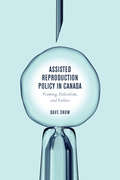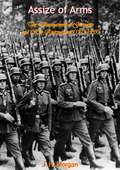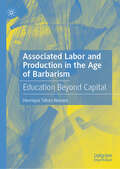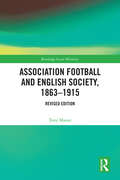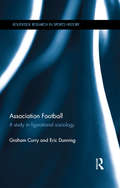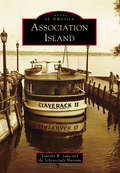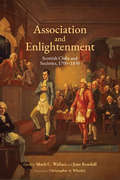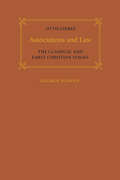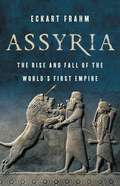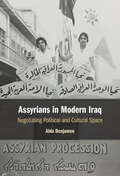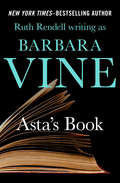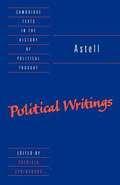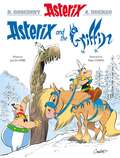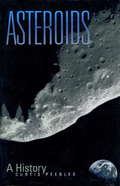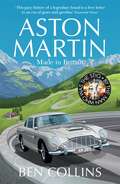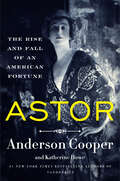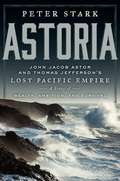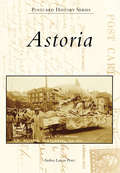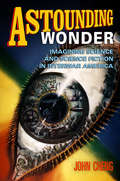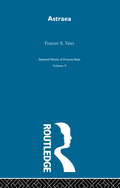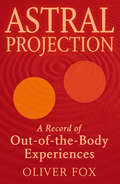- Table View
- List View
Assisted Reproduction Policy in Canada: Framing, Federalism, and Failure
by Dave SnowThe world has undergone a revolution in assisted reproduction, as processes such as in vitro fertilization, embryonic screening, and surrogacy have become commonplace. Yet when governments attempt to regulate this field, they have not always been successful. Canada is a case in point: six years after the federal government created comprehensive legislation, the Supreme Court of Canada struck it down for violating provincial authority over health. In Assisted Reproduction Policy in Canada, Dave Snow provides the first historical exploration of Canadian assisted reproduction policy, from the 1989 creation of the Royal Commission on New Reproductive Technologies to the present day. Snow argues the federal government’s policy failure can be traced to its contradictory "policy framing," which sent mixed messages about the purposes of the legislation. In light of the federal government’s diminished role, Snow examines how other institutions have made policy in this emerging field. Snow finds provincial governments, medical organizations, and even courts have engaged in considerable policymaking, particularly with respect to surrogacy, parentage, and clinical intervention. The result—a complex field of overlapping and often conflicting policies—paints a fascinating portrait of different political actors and institutions working together. Accessibly written yet comprehensive in scope, Assisted Reproduction Policy in Canada highlights how paying attention to multiple policymakers can improve our knowledge of health care regulation.
Assize of Arms: The Disarmament of Germany and Her Rearmament (1919-1939)
by J. H. MorganBritish lawyer and Brigadier-General John Hartman Morgan served as Deputy Adjutant-General in Berlin from 1919-1923 at the Inter-Allied Military Commission of Control—a term used in a series of peace treaties concluded after World War I (1914-1918) between different countries. Each of these treaties was concluded between the Principal Allied and Associated Powers (consisting of the United States of America, the British Empire, France, Italy and Japan) on the one hand, and one of the Central Powers like Germany, Turkey or Bulgaria.One of the terms of such treaties required conversion of all of the Central Powers’ military and armaments related production and related facilities into purely commercial use. The decision and the modus operandi to ensure this rested with a Military Inter-Allied Commission of Control. The Military Inter-Allied Commission of Control was also entrusted with a number of other responsibilities, including (a) setting the number of customs officials, local urban and rural police, forest guards and other officials under the control of the Government of the central power concerned; and (b) receiving information relating to the location of the stocks and depots of arms, munitions and war material and their operations.It was during this period of 1919-1923 that Brig.-Gen. Morgan witnessed German attempts to build up their army contravening the terms of the Treaty of Versailles, and he published his findings in October 1924 in the Quarterly Review, titled “The Disarmament of Germany and After.” However, it would not be until after World War II that he would decide to elaborate on this theme—the result is the present volume, Assize of Arms: The Disarmament of Germany and Her Rearmament (1919-1939).First published in 1945, it was intended to be published in two volumes; however, owing to Brig.-Gen. Morgan’s passing in 1955, it remained as a single volume.A valuable addition to any World Wars library.
Associated Labor and Production in the Age of Barbarism: Education Beyond Capital
by Henrique Tahan NovaesThe book focuses on different practices of associated labor in Brazil and Argentina, in the case of the workers’ recuperated factories, over the past 40 years. Novaes analyses labor practices from a critical Marxist perspective as a reaction to the misery of neoliberalism. Deindustrialization, austerity programs, increasing commodification and international competitiveness have severely deteriorated the living and working conditions of the majority of Latin Americans. However, alternative labor, production and educational practices have developed in this increasingly ruthless neoliberal capitalism. Although they are still small, they indicate a potential way out of the capitalist mode of production. Novaes directs his special attention to the “education beyond capital,” which has accompanied these alternative labor and production practices (from alternative job training in recuperated companies and the movement of landless rural workers MST).
Association Football and English Society, 1863-1915 (Routledge Soccer Histories)
by Tony MasonAssociation football, as it developed rapidly in the late-nineteenth and early-twentieth centuries, both reflected British society and helped to reshape it. In this newly released edition of Tony Mason’s essential account of the game’s rise, focusing on issues such as the amateur–professional divide, social class and mass spectatorship are seen as fundamental to our understanding of what is now a global phenomenon. Dilwyn Porter supplements this classic text with a brand new introduction.
Association Football: A Study in Figurational Sociology (Routledge Research in Sports History)
by Eric Dunning Graham CurryThis book presents a synthesis of the work on early football undertaken by the authors over the past two decades. It explores aspects of a figurational approach to sociology to examine the early development of football rules in the middle part of the nineteenth century. The book tests Dunning’s status rivalry hypothesis to contest Harvey’s view of football’s development which stresses an influential sub-culture outside the public schools. Status Rivalry re-states the primacy of these latter institutions in the growth of football and without it the sport’s story would remain skewed and unbalanced for future generations.
Association Island
by Schenectady Museum Timothy W. LakeMost people believe the General Electric retreat at Association Island was organized by GE. In reality, it was originally formed by several businessmen from the incandescent lamp industry; these men formed an association of lamp companies to compete with GE. A 1903 fishing trip to Henderson Harbor inspired them to purchase the island for their summer sojourns; however, ownership of the association and the island were eventually absorbed by GE, turning it into a full-scale resort for executives and managers of the ever-expanding corporation. Hotels, restaurants, garages, boats, fishing guides, managers, and maintenance workers from nearby Henderson Harbor were all tied to Association Island for the next 50 years. When GE gave it away, Association Island fell into a long and steady period of decline until it was turned into a camping resort for the 21st century. Association Island illustrates the financial and social impact of a significant corporation on a small fishing community.
Association and Enlightenment: Scottish Clubs and Societies, 1700-1830 (Studies in Eighteenth-Century Scotland)
by Bob Harris David Allan Rosalind Carr James J. Caudle Rhona Brown Jacqueline Jenkinson Ralph McLean Corey Andrews Martyn PowellSocial clubs as they existed in eighteenth- and early nineteenth-century Scotland were varied: they could be convivial, sporting, or scholarly, or they could be a significant and dynamic social force, committed to improvement and national regeneration as well as to sociability. The essays in this volume—the first full-length study of the subject in fifty years—examine the complex history of clubs and societies in Scotland from 1700 to 1830. Contributors address attitudes toward associations, their meeting-places and rituals, their links with the growth of the professions and with literary culture, and the ways in which they were structured by both class and gender. By widening the context in which clubs and societies are set, this volume offers a new framework for understanding them, bringing together the inheritance of the Scottish past, the unique and cohesive polite culture of the Scottish Enlightenment, and the broader context of associational patterns common to Britain, Ireland, and beyond.
Associations and Law: The Classical and Early Christian Stages
by Otto Gierke George HeimanGeorge Heiman has translated the discussion of classical and early Christian laws of association from the major works by Grotto Gierke, Das deutsche Genossenschaftsrecht. This work complements F.W. Maitland's translation of a later part under the title, The Political Theories of the Middle Ages, and E. Barker's translation of the third part, Natural Law and the Theory of Society, 1500-1800. Professor Heiman thus has completed the circle in bringing into English the eminent German jurist's historical analysis of the law. Professor Heiman furthermore has introduced the work with substantial, detailed, and scholarly essays on Gierke's work as a whole. He examines and explains Gierke's concept of the group-person and his organic view of the association, society, and the state, and clearly outlines the conflict between individualist Roman and collectivist Germanic law. This introduction provides the first complete analysis in English of the philosophy of a major representative of the school of historical law and a jurist whose thinking is reflected in the general civil code adopted in Germany at the end of the nineteenth century. The book will interest political and social theorists as well as those concerned with jurisprudence and legal philosophy.
Assyria: The Rise and Fall of the World's First Empire
by Eckart FrahmA new history of Assyria, the ancient civilization that set the model for future empires At its height in 660 BCE, the kingdom of Assyria stretched from the Mediterranean Sea to the Persian Gulf. It was the first empire the world had ever seen. Here, historian Eckart Frahm tells the epic story of Assyria and its formative role in global history. Assyria&’s wide-ranging conquests have long been known from the Hebrew Bible and later Greek accounts. But nearly two centuries of research now permit a rich picture of the Assyrians and their empire beyond the battlefield: their vast libraries and monumental sculptures, their elaborate trade and information networks, and the crucial role played by royal women. Although Assyria was crushed by rising powers in the late seventh century BCE, its legacy endured from the Babylonian and Persian empires to Rome and beyond. Assyria is a stunning and authoritative account of a civilization essential to understanding the ancient world and our own.
Assyrians in Modern Iraq: Negotiating Political and Cultural Space
by Alda BenjamenExamining the relationship between a strengthened Iraqi state under the Baʿth regime and the Assyrians, a Christian ethno-religious group, Alda Benjamen studies the role of minorities in twentieth-century Iraqi political and cultural history. Relying on extensive research in Iraq, including sources uncovered at the Iraqi National Archives in Baghdad, as well as in libraries and private collections in Erbil, Duhok, and Mosul, in Arabic and modern Aramaic, Benjamen foregrounds the Iraqi periphery as well as the history of bilingualism to challenge the monolingual narrative of the state. By exploring the role of Assyrians in Iraq's leftist and oppositional movements, including gendered representations of women, she demonstrates how, within newly politicized urban spaces, minorities became attracted to intellectual and political movements that allowed them to advance their own concerns while engaging with other Iraqis of their socio-economic background and relying on transnational community networks. Assyrian intellectuals not only negotiated but also resisted government policies through their cultural production, thereby achieving a softening of Baʿthist policies towards the Assyrians that differed markedly from those of later repressive eras.
Asta's Book
by Ruth RendellAn &“obsessively readable&” mystery from the New York Times–bestselling author of Dark Corners about a century-old diary that holds clues to a murder (The Sunday Telegraph). Asta Westerby is lonely. In 1905, shortly after coming to East London from Denmark with her husband and their two little boys, she feels like a stranger in a strange land. And it doesn&’t help that her husband is constantly away on business. Fortunately, she finds solace in her diary—and she continues to do so until 1967. Decades later, her granddaughter, Ann, finds the journal, and it becomes a literary sensation, offering an intimate view of Edwardian life. But it also appears to hold the key to an unsolved murder and the disappearance of a child. A modern masterpiece by the Edgar Award–winning author of the Inspector Wexford Mysteries, and an excellent choice for readers of P. D. James, Ian Rankin, or Scott Turow, Asta&’s Book is at once a crime story, a historical novel, and a psychological portrait told through the diary itself and through Ann, who is bent on unlocking the journal&’s excised mystery.
Astell: Political Writings
by Patricia Springborg Mary AstellThe writings of the High Church Tory pamphleteer Mary Astell (1666-1731) are a remarkable contribution to the constitutional debates that ushered in the modern democratic state. An interlocutor with Swift and Defoe, Astell was perhaps the first systematic critic of Locke's writings. Astell's political pamphlets Reflections upon Marriage, A Fair Way with the Dissenters, and An Impartial Enquiry into the Origins of Rebellion have never been reprinted in their entirety. This new edition makes accessible the major works of an important political theorist.
Asterix and the Griffin: Album 39 (Asterix #39)
by Jean-Yves FerriBe the first to read the next action-packed adventure from the indomitable Gauls by pre-ordering now!Follow Asterix and Obelix as they set out on their 39th adventure on a long journey in search of a strange and terrifying creature. Half-eagle, half-lion, and idolised and feared by ancient peoples, this creature is the griffin.How will Asterix, Obelix, Dogamatix, along with the Druid Getafix, get drawn into the epic, perilous quest to find this fantastical animal? Find out in the next instalment of this multi-million bestselling series.
Asteroids
by Curtis PeeblesAsteroids suggest images of a catastrophic impact with Earth, triggering infernos, tidal waves, famine, and death -- but these scenarios have obscured the larger story of how asteroids have been discovered and studied. During the past two centuries, the quest for knowledge about asteroids has involved eminent scientists and amateur astronomers, patient research and sudden intuition, advanced technology and the simplest of telescopes, newspaper headlines and Cold War secrets. Today, researchers have named and identified the mineral composition of these objects. They range in size from 33 feet to 580 miles wide and most are found in a belt between the orbits of Mars and Jupiter.Covering all aspects of asteroid investigation, Curtis Peebles shows how ideas about the orbiting boulders have evolved. He describes how such phenomena as the Moon's craters and dinosaur extinction were gradually, and by some scientists grudgingly, accepted as the results of asteroid impacts. He tells how a band of icy asteroids rimming the solar system, first proposed as a theory in the 1940s, was ignored for more than forty years until renewed interest and technological breakthroughs confirmed the existence of the Kuiper Belt. Peebles also chronicles the discovery of Shoemaker-Levy 9, a comet with twenty-two nuclei that crashed into Jupiter in 1994, releasing many times the energy of the world's nuclear arsenal.Showing how asteroid research is increasingly collaborative, the book provides insights into the evolution of scientific ideas and the ebb and flow of scientific debate.
Aston Martin
by Richard LoveysAston Martin is a chronological account of the company's foundation in 1913 through to the cenetenary celebrations -covering the the owners, financiers, and those that ran the company -and most importantly the cars. Richard Loveys details the extensive competition history including their finest win at the 1959 Le Mans 24 hour race and includes details on Aston Martin's most famous drivers. Loveys also looks at Aston Martins in popular culture, most famously driven by James Bond and the use of these cars in 007 films.Finally, Loveys looks at the culture of the Aston Martin with the Aston Martin Owners Club which actively runs events and encourages people to use their cars on the road or to race them and the Aston Martin Heritage Trust, which holds the official archive for the company, has an excellent museum and encourages people to learn about the marque.
Aston Martin: Made in Britain
by Ben CollinsFrom bestselling author, racer and stunt driver Ben Collins - the man who was The Stig - comes a story of spies, speed and hard-driving genius: a driver's love letter to one of the world's best-loved machines.Aston Martin's first, wickedly fast models were forged at a time when Ferrari's premises at Maranello was nothing but a ploughed field. This book celebrates a century of innovators who kept the fire burning brightly for over a century, from the visionary pioneers Martin and Bamford to modern-day design guru Adrian Newey; from a glamorous web of pre- and post-war spies and racing drivers, to David Brown and the achingly beautiful DB models beloved of Bonds past and present.Ben Collins explores the car with the double-o prefix from a unique perspective behind the wheel, carving through country lanes in his father's V8 Vantage, driving Aston Martins in four James Bond movies and competing against them in the legendary Le Mans 24-hour race.Ultimately, this is a very British success story: of a triumph of engineering that has burned brightly from the Roaring 20s to the 2020s, and an iconic car that never says die.(P)2020 Quercus Editions Limited
Aston Martin: Made in Britain (Planet Omar Ser.)
by Ben Collins'This pacy history of a legendary brand is a love letter to an era of gears and gasoline now accelerating towards its twilight' - Financial Times'[Told] with a genuine affection ... a glorious tale of British seat-of-the-pants invention' - Mail on Sunday---------From bestselling author, racer and stunt driver Ben Collins - the man who was The Stig - comes a story of spies, speed and hard-driving genius: a driver's love letter to one of the world's best-loved machines.Aston Martin's first, wickedly fast models were forged at a time when Ferrari's premises at Maranello was nothing but a ploughed field. This book celebrates a century of innovators who kept the fire burning brightly for over a century, from the visionary pioneers Martin and Bamford to modern-day design guru Adrian Newey; from a glamorous web of pre- and post-war spies and racing drivers, to David Brown and the achingly beautiful DB models beloved of Bonds past and present.Ben Collins explores the car with the double-o prefix from a unique perspective behind the wheel, carving through country lanes in his father's V8 Vantage, driving Aston Martins in four James Bond movies and competing against them in the legendary Le Mans 24-hour race.Ultimately, this is a very British success story: of a triumph of engineering that has burned brightly from the Roaring 20s to the 2020s, and an iconic car that never says die.
Astor Place Vintage: A Novel
by Stephanie LehmannWhen a New York City vintage clothing shop owner’s recent purchases contain a hidden journal from 1907, her entire life will be turned upside down in this “insightful, charming, and wholly entertaining novel” (Khaled Hosseini, author of The Kite Runner).Amanda Rosenbloom, proprietor of Astor Place Vintage, thinks she’son just another call to appraise and possibly purchase clothing from a wealthy, elderly woman. But after discovering a journal sewn into a fur muff, Amanda gets much more than she anticipated. The pages of the journal reveal the life of Olive Westcott, a young woman who had moved to Manhattan in 1907. Olive was set on pursuing a career as a department store buyer in an era when Victorian ideas, limiting a woman’s sphere to marriage and motherhood, were only beginning to give way to modern ways of thinking. As Amanda reads the journal, her life begins to unravel until she can no longer ignore this voice from the past. Despite being separated by one hundred years, Amanda finds she’s connected to Olive in ways neither could ever have imagined.
Astor: The Rise and Fall of an American Fortune
by Anderson Cooper Katherine HoweA NPR Best Book of the YearThe number one New York Times bestselling authors of Vanderbilt return with another riveting history of a legendary American family, the Astors, and how they built and lavished their fortune.The story of the Astors is a quintessentially American story—of ambition, invention, destruction, and reinvention.From 1783, when German immigrant John Jacob Astor first arrived in the United States, until 2009, when Brooke Astor’s son, Anthony Marshall, was convicted of defrauding his elderly mother, the Astor name occupied a unique place in American society.The family fortune, first made by a beaver trapping business that grew into an empire, was then amplified by holdings in Manhattan real estate. Over the ensuing generations, Astors ruled Gilded Age New York society and inserted themselves into political and cultural life, but also suffered the most famous loss on the Titanic, one of many shocking and unexpected twists in the family’s story.In this unconventional, page-turning historical biography, featuring black-and-white and color photographs, #1 New York Times bestselling authors Anderson Cooper and Katherine Howe chronicle the lives of the Astors and explore what the Astor name has come to mean in America—offering a window onto the making of America itself.
Astoria
by Peter StarkIn 1810, John Jacob Astor sent out two advance parties to settle the wild, unclaimed western coast of North America. More than half of his men died violent deaths. The others survived starvation, madness, and greed to shape the destiny of a continent.At a time when the edge of American settlement barely reached beyond the Appalachian Mountains, two visionaries, President Thomas Jefferson and millionaire John Jacob Astor, foresaw that one day the Pacific would dominate world trade as much as the Atlantic did in their day. Just two years after the Lewis and Clark expedition concluded in 1806, Jefferson and Astor turned their sights westward once again. Thus began one of history's dramatic but largely forgotten turning points in the conquest of the North American continent.Astoria is the harrowing tale of the quest to settle a Jamestown-like colony on the Pacific coast. Astor set out to establish a global trade network based at the mouth of the Columbia River in what is now Oregon, while Jefferson envisioned a separate democracy on the western coast that would spread eastward to meet the young United States.Astor backed this ambitious enterprise with the vast for-tune he'd made in the fur trade and in New York real estate since arriving in the United States as a near-penniless immigrant soon after the Revolutionary War. He dispatched two groups of men west: one by sea around the southern tip of South America and one by land over the Rockies. The Overland Party, led by the gentlemanly American businessman Wilson Price Hunt, combined French-Canadian voyageurs, Scottish fur traders, American woodsmen, and an extraordinary Native American woman with two toddlers. The Seagoing Party, sailing aboard the ship Tonquin, likewise was a volatile microcosm of contemporary North America. Under the bitter eye of Captain Jonathan Thorn, a young U.S. naval hero whose unyielding, belligerent nature was better suited to battle than to negotiating cultural differences, the Tonquin made tumultuous progress toward its violent end.Unfolding from 1810 to 1813, Astoria is a tale of high adventure and incredible hardship, drawing extensively on firsthand accounts of those who made the journey. Though the colony itself would be short-lived, its founders opened provincial American eyes to the remarkable potential of the western coast, discovered the route that became the Oregon Trail, and permanently altered the nation's landscape and global standing.
Astoria (Postcard History)
by Andrea Larson PerezFortunate to be located in the northwest corner of Oregon, where the mighty Columbia River flows to the Pacific Ocean, Astoria has always inspired residents and visitors. The town's spectacular natural beauty and accessible everyday life invites documentation. Those lucky enough to experience Astoria sense they are witnessing something special. More than a century ago, it was a place of big fish, big trees, big dreams, and big personalities. Luckily, many professional photographers and everyday shutterbugs made it their business to capture life on the Lower Columbia from the earliest days of photography. Today, there are fewer giant Chinooks and the remaining old growth is protected, but the town, dreams, personalities, and photographs remain.
Astounding Wonder
by John ChengWhen physicist Robert Goddard, whose career was inspired by H. G. Wells's War of the Worlds, published "A Method of Reaching Extreme Altitudes," the response was electric. Newspaper headlines across the country announced, "Modern Jules Verne Invents Rocket to Reach Moon," while people from around the world, including two World War I pilots, volunteered as pioneers in space exploration. Though premature (Goddard's rocket, alas, was only imagined), the episode demonstrated not only science's general popularity but also its intersection with interwar popular and commercial culture. In that intersection, the stories that inspired Goddard and others became a recognizable genre: science fiction. Astounding Wonder explores science fiction's emergence in the era's "pulps," colorful magazines that shouted from the newsstands, attracting an extraordinarily loyal and active audience.Pulps invited readers not only to read science fiction but also to participate in it, joining writers and editors in celebrating a collective wonder for and investment in the potential of science. But in conjuring fantastic machines, travel across time and space, unexplored worlds, and alien foes, science fiction offered more than rousing adventure and romance. It also assuaged contemporary concerns about nation, gender, race, authority, ability, and progress--about the place of ordinary individuals within modern science and society--in the process freeing readers to debate scientific theories and implications separate from such concerns.Readers similarly sought to establish their worth and place outside the pulps. Organizing clubs and conventions and producing their own magazines, some expanded science fiction's community and created a fan subculture separate from the professional pulp industry. Others formed societies to launch and experiment with rockets. From debating relativity and the use of slang in the future to printing purple fanzines and calculating the speed of spaceships, fans' enthusiastic industry revealed the tensions between popular science and modern science. Even as it inspired readers' imagination and activities, science fiction's participatory ethos sparked debates about amateurs and professionals that divided the worlds of science fiction in the 1930s and after.
Astraea - Yates: The Imperial Theme In The Sixteenth Century (Peregrine Bks.)
by Frances A. YatesThis is Volume V of selected works of Frances A. Yates. Astraea looks at the Imperial theme in the sixteenth century and includes Charles V and the idea of Empire to the Tudor Imperial Reform and the French Monarchy.
Astral Projection: A Record Of Out-of-body Experiences
by Oliver FoxAstral Projection, first published in 1962 (based on papers prepared in the 1930s), is a classic account of one man's own documented experiences with 'astral projection,' or as he prefers, 'out-of-body' experiences. The book also serves as a 'how-to' guide, describing two techniques for initiating an out-of-body experience: dream awakening and the pineal doorway. Clearly written with a refreshing charm and sincerity, Astral Projection remains a useful guide to those exploring this realm of psychic experience. Oliver Fox was a pseudonym for Hugh George Callaway (1885-1949), an English short story writer, poet and occultist.
